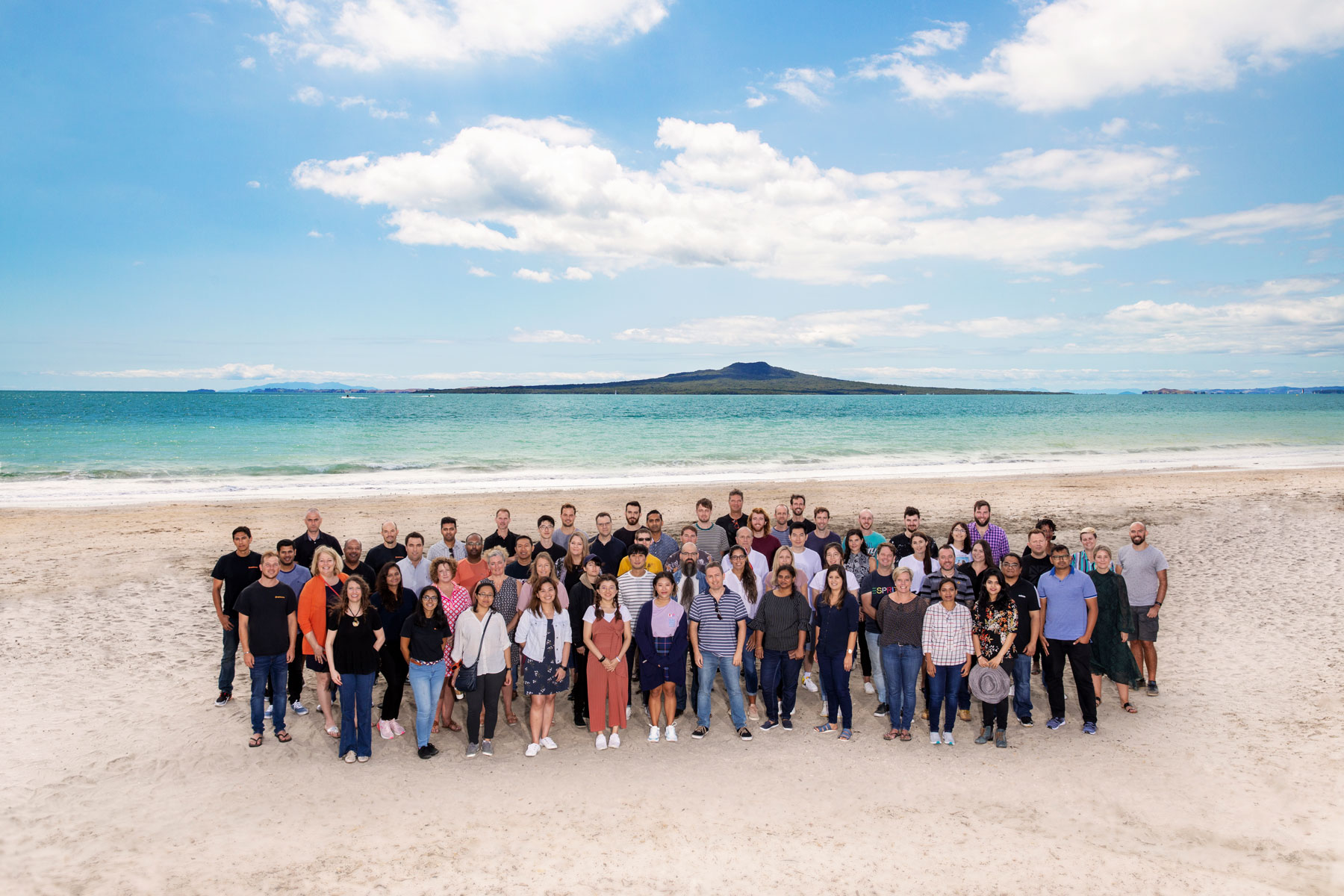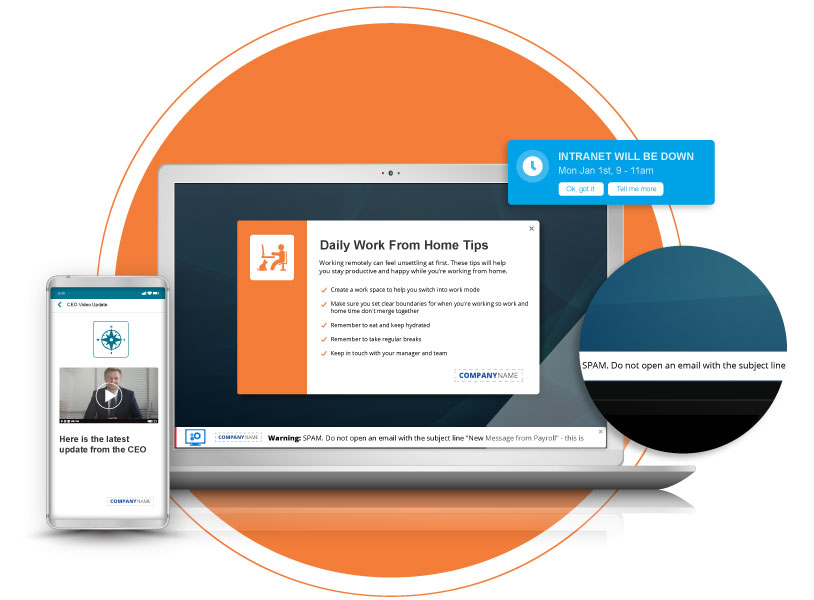Effective internal communications are paramount to a successful business. But in a digitally congested landscape of emails, online chat apps and other collaboration tools, large enterprises struggle to cut through the noise and reach their employees in a meaningful way. New Zealand innovator SnapComms set out to solve this challenge through a single communications software platform. And organisations across the globe got the message. With support from Microsoft, SnapComms has grown from a single New Zealand customer a decade ago to helping big businesses all over the world stay connected with their employees and deliver better, faster service.
In an ideal world, large enterprises would be able to communicate with their employees in a seamlessly instant way. But as any manager knows, being able to send information instantly isn’t the same as ensuring it’s received. When the average office worker receives an average of 120 emails per day, along with computers, tablets, smartphones and smart watches all delivering us a constant stream of notifications and messages from news sites, social media, apps, email and streaming services (and even old-fashioned phone calls), getting the attention of anyone can be difficult.
“Large enterprises struggle to reach employees. They are just too busy and there are so many other distractions in the workplace. It’s really hard to get cut through,” says Tyrell Cooney, General Manager of Technology at SnapComms.
By the time information trickles through the organisation, a lot of time has already passed, and vital actions may have been missed, not to mention some staff remaining in the dark about crucial updates. Imagine missing a key meeting to discuss the future of your department because it got buried in your inbox, or even worse, an urgent call for assistance to deal with a medical emergency. Sarah Perry and Chris Leonard, co-founders of SnapComms, refused to accept that it was just the nature of being a large organisation to cope with these challenges. They set out to develop a scalable tool that would allow organisations to radically improve their internal communications.
Their vision was to create a single platform that would make it easy for employers to grab attention. Urgent “read now” screen takeovers, tickers with scrolling updates like on news sites and even screensavers and wallpapers transforming into digital billboards were all part of their mission. To cap it off, they planned to introduce quizzes for employees to gauge whether the messages had succeeded in changing behaviour.
However, SnapComms was just a small Kiwi business, which started with just one customer – Vodafone New Zealand. To grab some attention of its own, the platform needed a technology partner with the right tools and connections to make the kind of noise that would turn heads around the world.
FastTrack to global success
That partner was, of course, Microsoft. SnapComms picked Azure to develop and host its software in the cloud on a global scale.
Says Cooney: “We’re asked all the time why we chose Microsoft and it came down to a number of factors. Firstly, our initial software system just wasn’t working. We’d learnt that managing your own infrastructure via physical machines was hard work and time intensive. We also realised that as we stored more and more customer data, we needed really robust security processes and systems in place. Under this framework we just couldn’t have managed the risks if we’d kept the system on physical machines.”
The business required a platform that could deliver flexibility for global enterprises of all different sizes and industries. From IT to HR to emergency services to hospitals and everything in between, SnapComms’ internal communications tool needed to be scalable, so that it could adapt to the differing needs of all kinds of customers,
Along with a platform that integrated smoothly with SnapComms’ web programming software, Azure provided the sort of combination that enabled SnapComms to be nimble, creative and clever but also deploy its solutions rapidly anywhere in the world, growing alongside its customers.
Using Azure has also helped SnapComms enhance their online security and data privacy capabilities, through supporting the achievement of ISO certification and enabling fast-track compliance to SOC 2.
Microsoft also put SnapComms on the fast track to success, via its FastTrack for Azure programme. Microsoft provided SnapComms with funding and tailored guidance from Azure engineers that helped with the rapid design and deployment of its cloud solutions, and to make the platform and its services more secure and resilient.
“The support we’ve received from Microsoft has been great and they are always looking out for our best interests,” says Cooney.
Communications technology that’s saving lives
The result of this collaboration is not only massive growth for SnapComms, it’s also saving lives.
From its small beginnings with a single customer in 2007, the SnapComms platform now has upwards of 2.5 million enterprise users in more than 75 countries, including Fortune 50 companies. The largest sector is healthcare.
In the current climate, strong internal communications are more vital than ever. No sector proves this more than healthcare. Healthcare facilities are diverse, complex and fast-paced environments, with staff that operate across multiple departments, shifts and locations. Imagine a world where there are communication disconnects between doctors and nurses, or surgeons and their surgical staff. Effective communication can literally be a matter of life and death.
Healthcare providers make up 35% of customers for SnapComms, with hospitals using its platform to keep doctors and nurses up to date with essential advice, government announcements and critical operational issues.
“SnapComms can be really useful during times of crisis, like for example when a hospital has a power outage. The laptops and even phones of those in the hospital are still working off battery power, so we allow the head of the hospital to continue communicating with staff about evacuation plans, explain what has happened and calm fears while the power is restored,” Cooney explains.
“There are more than 6,000 hospitals in the US alone and this is just one example of a crisis they may experience. We’re now working to tell our story and encourage more healthcare customers to learn how they can reach their employees more effectively during critical situations.”
There is also a real opportunity for helping more New Zealand companies, as Steve Hornblow, Partner Development Lead at Microsoft New Zealand, notes.
“As ways of working dramatically shift in response to global events as well as greater demand for flexibility, this kind of communications technology really comes into its own. We see so much more potential for SnapComms and its amazing platform because they make it easier to reach key staff quickly, via more than one device. We couldn’t be more thrilled with the success SnapComms has already achieved – but I have a strong sense we ain’t seen nothing yet.”
To learn more about SnapComms, click here.


